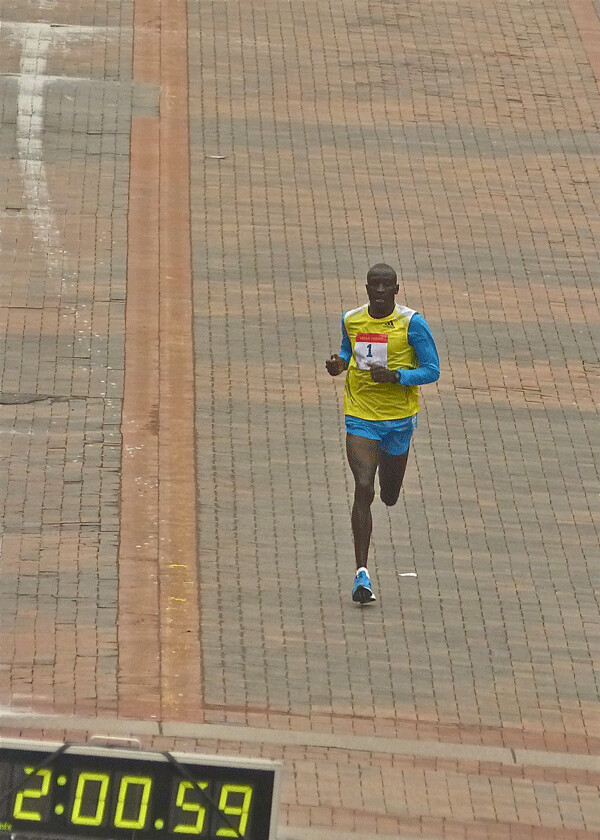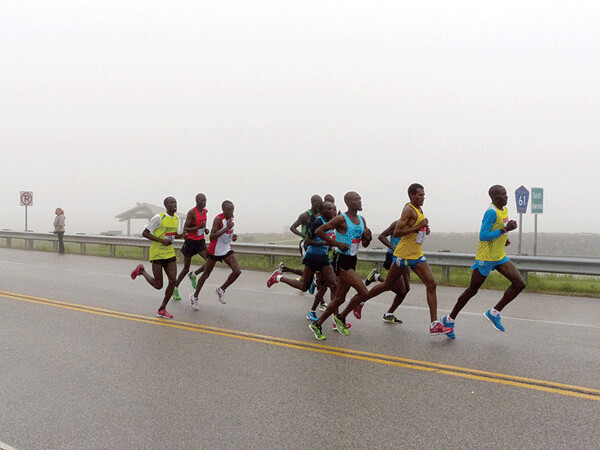News & Articles
Browse all content by date.


A strange thing happened in the 2014 Grandma’s Marathon. Dominic Ondoro, from Kenya, won the event in a record time of 2 hours, 9 minutes, and 6 seconds.
One year later, Elisha Barno, also from Kenya, won it, and then he proceeded to win it again, and again, and again. Incredibly, Barno has won the last four Grandma’s Marathons, but he has not broken his friend and countryman Ondoro’s record.
Both of those elite runners will be here this year, for the 43rd Grandma’s, and without a doubt, Barno will be out to improve on his 2:10.06 winning time from 2018, and just as certainly, Ondoro would like to be the one to prevent his record from falling. The story of the record stands alone as an annual highlight of Grandma’s, and it will be told some more this week.
A couple dozen East Africans will compete in Grandma’s, as the race has attracted them so consistently that It got to be something of a standing joke to ask: “Which Kenyan will win this year’s Grandma’s Marathon?”
Sarcasm aside, the influx of elite runners, primarily from East Africa, pretty much took over Grandma’s in the last two decades, and they kept returning, and bringing friends, who enjoyed the legendary small-town charm of Grandma’s and the neighborly treatment they appreciated.
The speed and talent of men who grew up running from the foothills outside of Nairobi to school, back home for lunch, back to school for afternoon studies, and — after time for training — back home, makes them virtually born and groomed to be distance runners. Their ability to earn a living by running led many of them to come to the U.S. for big paydays. They became dominant at Grandma’s, although a curious fact surrounded Grandma’s from the fifth year of its existence in 1981 until 2014.
Dick Beardsley, being pushed to the limit by two-time champion Garry Bjorklund, ran the distance in 2 hours, 9 minutes, and 37 seconds to win in 1981. His time was the course and event record, and it stood…and stood…and stood… Despite the numerous speedy Kenyan runners who won nearly every race, they never threatened to break the record set by the Minnesota tandem of Beardsley trying to stay ahead of Bjorklund, the hometown hero from the Duluth suburb of Twig.
Mark Curp, from Missouri, won the 1995 race, but in the 23 years since then, only one U.S. runner broke through the string of “imports,” mostly from Kenya. Runners from Kenya won 16 of those 23 Grandma’s Marathons, along with two from Ethiopia, two from Russia, and one each from Tanzania and Belarus. The only U.S. runner to break through in the last 23 years was Minnesotan Chris Raabe, living in Washington, D.C, won the 2009 Grandma’s.
Conditions could be perfect on Saturday morning, for distance runners, that is. Maybe less-perfect for tourists and residents, but with chilly temperature, the runners should be able to go harder, longer, without fatigue as they negotiate the 26.2 miles from Two Harbors to Duluth’s Canal Park.
While Barno was winning his fourth straight Grandma’s last June, Kellyn Taylor, from Flagstaff, Arizona, showed ump and won the women’s competition with a time of 2:24.28 — the event record for women, easily breaking the 2013 women’s record of 2:26.32, set by Sarah Kiptoo, from Kenya.
Taylor will not be competing this year, and the course, which has been altered by the enormous construction project from 4th Avenue East to Lake Avenue, could be wide open to the women, now that they’ve seen what can be done.
As for the men? If the question is “Which Kenyan will win?”, the answer going for those who have watched the last five Grandma’s Marathons might logically answer: Elisha Barno, but maybe Dominic Ondoro.

JOE MAUER CEREMONY EMOTIONAL, TOUCHING
When I coached my two sons through different youth baseball teams, I knew we had reached an era where young players could watch their favorite players on television, and emulate them when they played, by copying their mannerisms.
I also covered the Twins some during those years, including a series they played in Boston, and later a return series when the Red Sox came to the Twin Cities. One of those years was the year the Red Sox broke in two spectacular rookie outfielders — Fred Lynn and Jim Rice.
Lynn was a left-handed hitter, and Rice hit from the right side, for better power if not as high an average. The two led the Red Sox up into contention, for years.
When both my sons started swinging plastic bats at waffle balls, I saw to it they both tried hitting right-handed and left-handed, because both of them shot left in hockey, and while they threw right-handed, I was hoping they’d feel good hitting left in baseball because of the obvious advantages left-handed hitters have in baseball — primarily facing a predominance of right-handed pitchers, and starting three feet closer to first base on their first step from the batter’s box.
So I suggested that both of them watch Freddie Lynn, because he had what I figured was the most perfect swing in the game. No weird footwork, no odd holding of the bat, but his hands back, and high enough so his elbow was about even with his ear, and his hands pulled back, in hitting position from the start. Then he swung with power and smoothness, and he hit balls all over the field. Game after game, Lynn would bat third and get a hit, and Rice would come up and pound one somewhere. Instant rally.
In the last two decades, there have been so many new teams and players that it’s hard to keep track with all the expansion. But you needn’t know anything about the fundamentals of the game to realize that a young kid from Cretin-Derham Hall High School, gifted in football, basketball and baseball, signed as a catcher for the Twins. He did a great job behind the plate, and he was fantastic at bat. Left-handed hitter, upright stance with no gimmicks, and a smooth, perfect swing.
More often than not, he was good for at least three line drives a game, and he went on to win a batting title, then another, and then a third. No catcher had ever won the league batting title, and here Mauer did it three times. My sons knew what I thought of Mauer, and his perfect swing — every bit as perfect as Fred Lynn’s from an earlier time — would have been the example I would want young players to watch. Find a flaw, and let me know; otherwise, copy him.
Mauer’s perfect swing didn’t produce the home runs that Lynn’s did, but he hit trademark line drives, mostly to left-center. He hit in the mid-.300 range, and years later, when a couple injuries slowed his production, he started drawing criticism for not hitting enough home runs, for making too much money, and for hurting the Twins chances to improve because the team had so much investment tied up in him.
Hogwash, all of it. Mauer was brilliant from start to finish of his career, which ended after last season. He decided he wanted to spend more time at home with his wife, their twin daughters, and his new infant son.
Last weekend, they dedicated their homestead to Joe Mauer night, and weekend. They held a very tasteful and well-planned pre-game ceremony for Mauer, who sat on the field looking good, but strange, in a business suit, with his family.
They retired his No. 7, and it was all done tastefully, with many former teammates showing up to honor him. Maybe some day, the Twins will invite Joe to come back as a batting coach. He wouldn’t have to say much, or over-teach any players. He could do it all by just stepping up to the plate and swinging the bat. The best instruction there is.
| Tweet |


